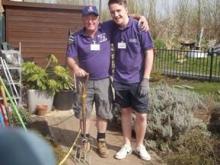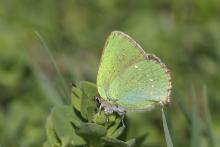
Not everyone would be happy to come across a Dingy Footman on a dark night, but in a recent survey of moths by Butterfly Conservation at Southam Quarry, in county Warwickshire, UK, a lepidopterist was delighted to see one.
This moth and, more importantly, the Pammene Suspectana are just two of 120 species surveyed at the site, making Southam Quarry one of the most important sites in the Midlands for both moths and butterflies.
A ‘first’ for Warwickshire and the rarest moth spotted at the site so far is the Pammene Suspectana listed in the Red Data book, a list of species of whose continued existence is threatened. Pammene Suspectana is solely dependent on the Ash tree for its food, and at Southam ash trees have been planted along the roadside on the edge of the site to provide screening from the operations.
The other rare species spotted at the site is the dark smudge, Ypsolopha Horridella, which is ‘Nationally Scarce’, according to the Butterfly Conservation’s Moth Report. Horridella is derived from horridus meaning shaggy and highlights the raised crests on the moth’s wings.
“I was delighted to find so many different species during the recent survey, particularly the Pammenes Suspectana which is a new species for Warwickshire. This is yet further evidence that the
“The site has a varied habitat including rare calcareous and scrubby grasslands as well as wet and marshy areas. Cemex has seeded a varied wildflower mix to help the biodiversity and in between the seeded areas there is a lot of bare ground which allows increasing ground temperatures,” says Michael Slater, volunteer conservation officer for Butterfly Conservation.
Other species found at Southam include garden pebble, marbled beauty, small phoenix and wormwood pug. These and other moths have a vital role in nature as a pollinator, often they are as beautiful as butterflies and can have superb camouflage. For example, the buff-tip is easily mistaken for a broken twig of silver birch.
Southam Quarry has provided the ideal breeding ground for the Small Blue butterfly, where the largest colony in the Midlands now exists. The area planted with the wildflower mix has resulted in the Small Blue caterpillar food plant, Kidney Vetch, growing extensively.
The scheme, launched by the UK-based firm in 2014, sees Hope employees choosing to partake in charity work close to their heart, with the organisation offering two fully paid days leave to each employee per year.
Hope staff are encouraged to choose the activities or causes that most resonate with them. The 100 days of voluntary activity carried out reflect the organisation’s diversity with projects ranging from DIY activities including painting, decorating and cleaning; gardening and collection of wildlife data; races and physical challenges, and foster care training.
Beneficiary organisations have varied depending on the team or employees’ connections and interests, and have included several local hospices, the Bristol Royal Hospital for Children, Derbyshire Local Authority and Rossington Riding for the Disabled.
Alongside hands-on physical activity, Hope has encouraged staff to use their core skills to contribute to their chosen projects. Hope employees have carried out skills-based volunteering, providing interview skills training to a local college. Skills-based volunteering is increasingly celebrated in the charity sector, as it helps to provide a more meaningful and lasting contribution to specific projects.
Hope for Others reflects the organisation’s core values of people, growth and sustainability, strengthening internal commitment and team unity, while also promoting meaningful community engagement.
Cara Mills, Hope’s regional director central, said: “Volunteering is an excellent team building activity and really makes you drop any barriers that you may have had. It is also a great stress release.
“At the end of the day you leave feeling immense pride and worth, having given something back to the community, and it doesn’t end there - you end up creating a strong friendship with people in the local community, which is really what Hope is about.”
Amit Bhatia, Hope’s chairman, says: “I’m delighted we have reached 100 days of helping, and now we have real momentum I expect we’ll complete another 100 fairly soon. It won’t be long until we’re celebrating 1,000 days.”






